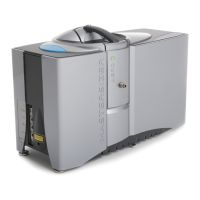Viewing measurement results Chapter 5
Mastersizer 3000 Page 5-21
Optical models
This section contrasts the Fraunhofer approximation used in some instruments
with the Mie theory which underpins Mastersizer operation. Although Mie is the
preferred scattering model, users can also select Fraunhofer if required from the
Data Processing - Analysis measurement settings.
Fraunhofer approximation
Older instruments and some existing instruments rely on the Fraunhofer approxi-
mation only. This assumes that:
The particle is much larger than the wavelength of light employed. ISO 13320
defines this as being greater than 40x wavelength (25μm when a He-Ne laser is
used).
All sizes of particle scatter with equal efficiencies.
The particle is opaque and transmits no light.
These assumptions are incorrect for many materials and for small particles they can
give rise to errors approaching 30%, especially when the relative refractive index of
the material and medium is close to unity, or when the particles are transparent.
When the particle size approaches the wavelength of light the scattering efficiency
becomes a complex function with maxima and minima present.
Mie theory
The Mastersizer uses the full Mie theory which completely solves the equations for
interaction of light with matter. This allows completely accurate results over a large
size range.
Requirements for using Mie
The Mie theory assumes the particle is spherical, as opposed to Fraunhofer, which
is a projected area prediction. The penalty for this complete accuracy is that the
refractive indices for the material and medium must be known and the absorption
part of the refractive index must be known or estimated. However, for the majority
of users this will present no problems as these values either will be known or can be
measured.
A standard set of materials is available for selection in the SOP (presented in the
Sample - Material section of the measurement settings). Further materials can be
defined by a user within the materials database, but the following parameters must
be specified accurately:

